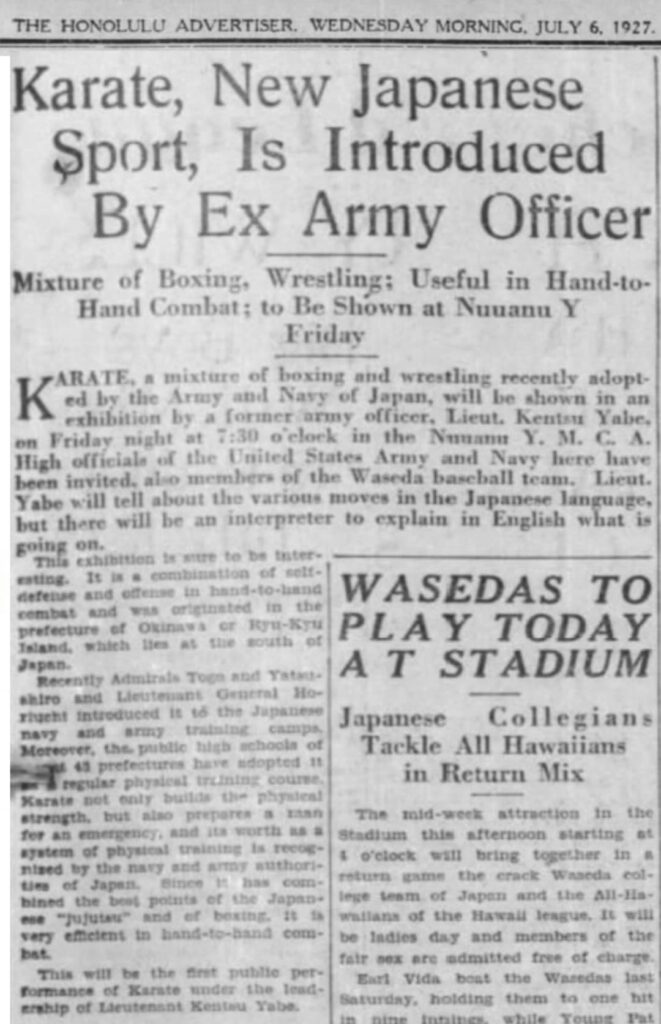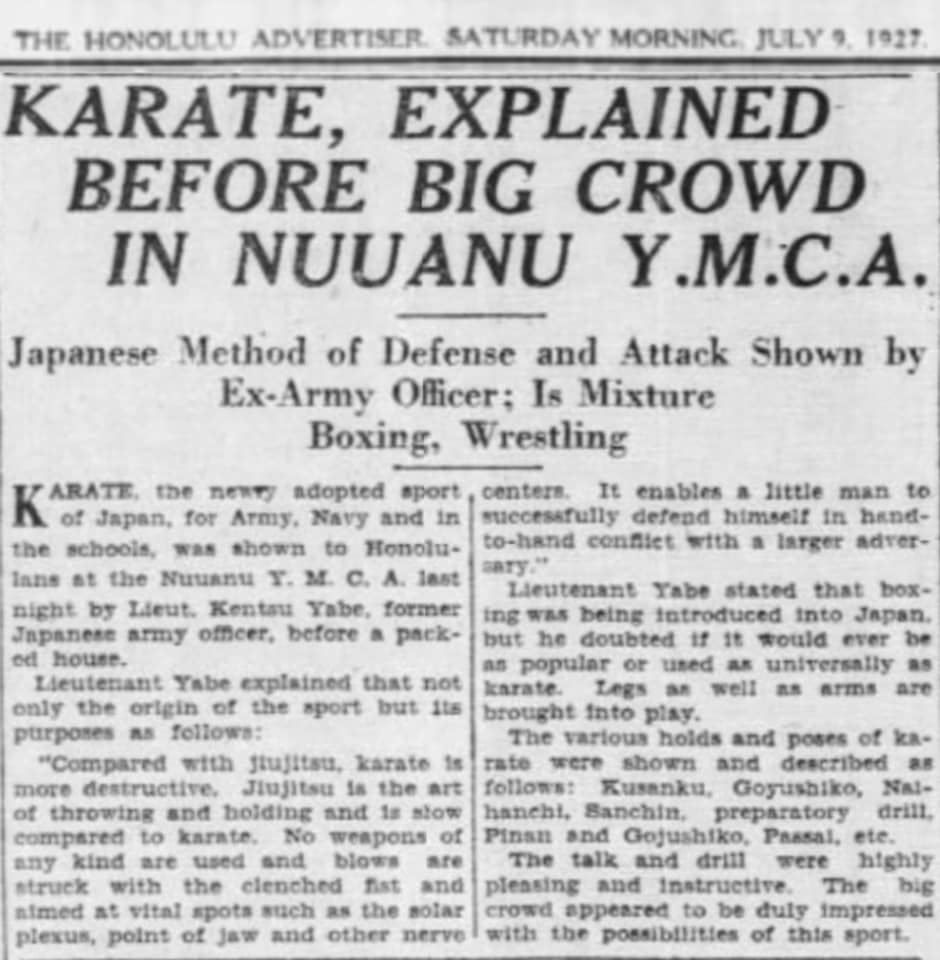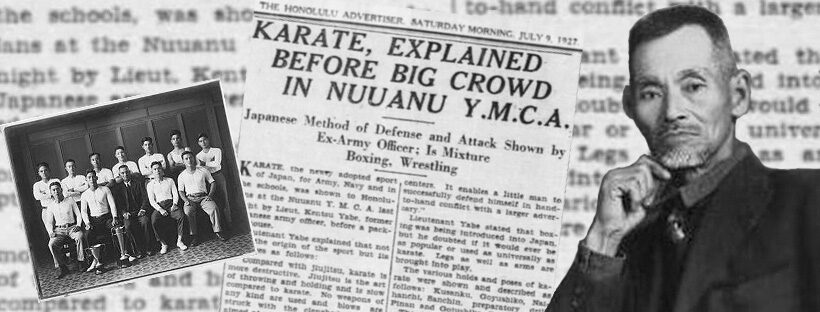Recently, the karateka Gary Suley shared two noteworthy historical records with the Karate community, despite not reporting any recent discovery or unknown facts. These are two newspaper clippings about a presentation that okinawan master Kentsu Yabu (屋部 憲通, 1866-1937), a student of Sokon Matsumura and Anko Itosu, made in Hawaii in 1927. Apparently it is one of the first records of the term “Karate” made in English, even before the master meeting that took place in 1936 to change the kanji of art from 唐手 (Tode/Karate, chinese hand) to 空手 (Karate, empty hand).
At that time, the two readings for 唐手, Tode or Karate, were used, depending a lot on the and training preferences, including politics, of the person using it. I intend to address this in a future text, but basically, saying “Karate” was more neutral or ambiguous. Unlike Okinawa, which for many years was culturally influenced by China, in mainland Japan there was an aversion to Chinese things. Considering that Kentsu Yabu was a military man, aligned with the Japanese influence on Okinawa, and served in the first Sino-Japanese war, it seems easy to imagine why the term Karate was used.
The presentation cited in the newspapers took place during a Yabu stay in Hawaii for almost nine months, during which time he taught Karate. Just before that, in 1926, he had traveled to California for the birth of the fourth daughter of his firstborn, Kenden Yabu. Kentsu Yabu did not teach Karate during that family visit.

Yabu in Hawaii, 1927. Courtesy Charles Goodin.
During his time in Hawaii, Kentsu Yabu gave two public demonstrations at Nuuanu YMCA. The first was smaller, at the end of March, essentially a lecture for the Thursday Luncheon Club. The second, which the newspaper clippings refer to, was held on July 8 (Friday) for a large and “impressed” audience (an article in the Journal of Combative Sport says there were about 200 people). The clippings, from The Honolulu Advertiser, are from the announcement of the presentation and the report made the day after the event.
In the newspaper, it is said that the following kata were featured at the event: Kusanku, Gojushiho, Naihanchi, Sanchin, Pinan and Passai. This relationship is interesting because there is some controversy about which kata Yabu practiced. The five mentioned that are commonly classified as “Shuri-Te” (ten kata, if you consider that Pinan is a series of five), have already been confirmed by other records, among them those related to Yabu’s student who came to Brazil, Motoku Yabiku. Yabiku taught at least Pinan, Naihanchi, Gojushiho and Kusanku. Only Sanchin (usually related to “Naha-Te”) seems like a point outside the curve on the list of Yabu’s presentation.
Another very relevant detail of these clippings is the way in which Karate is described: “mixture of boxing and wrestling” and combination of the “best points of Japanese ‘jujutsu’ and boxing”. We don’t know who wrote the news, probably a newspaper employee, so the description may seem simplistic. Anyway, it is certainly not a description that someone in the same situation, even being a layman, would wrote seeing a presentation of the Karate that was becoming popular in the universities of Japan in the same period or even the modern interpretation spread today through the world. This is because there was a modification process in which many original concepts were taught only to a few, were left in the background, were misinterpreted or simply omitted.
Within these simplistic descriptions of the newspaper there is more evidence, among other historical ones, of something that should be common knowledge, that Karate is much more than punches and kicks. It is an art originally created for civilian self-defense and, therefore, uses everything that is necessary in this sense, in an integrated manner, including techniques called “grappling”. Everything is an integral part of what Karate is, as simple as that. Similar descriptions are even present in other sources, such as in the book Ryukyu Kenpo Tode (1922), by Gichin Funakoshi, and in a 1949 article on Kanken Toyama (Oyadomari) .¹
Obviously, different contexts and objectives require different approaches. This is also evidenced by the explanation given by Yabu during the event, that jujutsu is an “art of throwing and holding” while in Karate “blows are struck with the clenched fist and aimed at vital spots such as the solar plexus, point of jaw and other nerve centers”. Karate is not jujutsu, judo or wrestling. Karate is Karate.
The way in which our art uses the elements of grappling, to facilitate and enhance the concussive techniques, is directly linked with other technical and tactical elements that serious practitioners of the art must study, research and put into practice. They are teachings intrinsic to the art and also transmitted by other masters, such as Itosu, Funakoshi, Motobu, Mabuni and Miyagi, to name a few. The account about Yabu reinforces these teachings and historical evidence, in addition to being an important record of a transition period from old to modern Karate.
Below, the two newspaper clippings. An important detail is that the surname of the master is spelled “Yabe” instead of “Yabu”, as it is another possible transliteration for 屋部. It was a common spelling used in documents of the time, including that of his son Kenden, who established his “Yabe” family in the United States.


¹ Thanks to Aritomo Ito for his collaboration.
